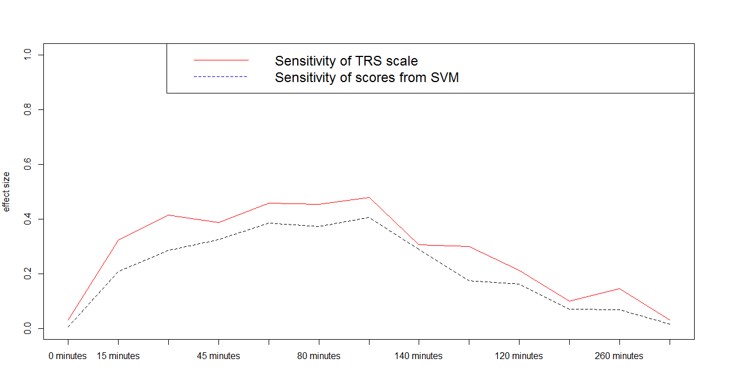Session Information
Date: Sunday, October 7, 2018
Session Title: Technology
Session Time: 1:45pm-3:15pm
Location: Hall 3FG
Objective: To assess the feasibility of measuring Parkinson’s disease (PD) motor symptoms with a multi-sensor data fusion method. More specifically, the aim is to assess validity, reliability and sensitivity to treatment of the methods.
Background: Data from 19 advanced PD patients (Gender: 14 males and 5 females, mean age: 71.4, mean years with PD: 9.7, mean years with levodopa: 9.5) were collected in a single center, open label, single dose clinical trial in Sweden [1].
Methods: The patients performed leg agility and 2-5 meter straight walking tests while wearing motion sensors on their limbs. They performed the tests at baseline, at the time they received the morning dose, and at pre-specified time points until the medication wore off. While performing the tests the patients were video recorded. The videos were observed by three movement disorder specialists who rated the symptoms using a treatment response scale (TRS), ranging from -3 (very off) to 3 (very dyskinetic). The sensor data consisted of lower limb data during leg agility, upper limb data during walking, and lower limb data during walking. Time series analysis was performed on the raw sensor data extracted from 17 patients to derive a set of quantitative measures, which were then used during machine learning to be mapped to mean ratings of the three raters on the TRS scale. Combinations of data were tested during the machine learning procedure.
Results: Using data from both tests, the Support Vector Machines (SVM) could predict the motor states of the patients on the TRS scale with a good agreement in relation to the mean ratings of the three raters (correlation coefficient = 0.92, root mean square error = 0.42, p<0.001). Additionally, there was good test-retest reliability of the SVM scores during baseline and second tests with intraclass-correlation coefficient of 0.84. Sensitivity to treatment for SVM was good (Figure 1), indicating its ability to detect changes in motor symptoms. The upper limb data during walking was more informative than lower limb data during walking since SVMs had higher correlation coefficient to mean ratings.
Conclusions: The methodology demonstrates good validity, reliability, and sensitivity to treatment. This indicates that it could be useful for individualized optimization of treatments among PD patients, leading to an improvement in health-related quality of life.
References: [1] M. Senek, S. M. Aquilonius, H. Askmark, F. Bergquist, R. Constantinescu, A. Ericsson, et al., “Levodopa/carbidopa microtablets in Parkinson’s disease: a study of pharmacokinetics and blinded motor assessment,” Eur J Clin Pharmacol, Jan 18 2017. [2] C. G. Goetz, G. T. Stebbins, K. A. Chung, R. A. Hauser, J. M. Miyasaki, A. P. Nicholas, et al., “Which dyskinesia scale best detects treatment response?,” Mov Disord, vol. 28, pp. 341-6, Mar 2013.
To cite this abstract in AMA style:
M. Memedi, S. Aghanavesi, D. Nyholm, F. Bergquist, M. Senek. Feasibility of a multi-sensor data fusion method for assessment of Parkinson’s disease motor symptoms [abstract]. Mov Disord. 2018; 33 (suppl 2). https://www.mdsabstracts.org/abstract/feasibility-of-a-multi-sensor-data-fusion-method-for-assessment-of-parkinsons-disease-motor-symptoms/. Accessed October 22, 2025.« Back to 2018 International Congress
MDS Abstracts - https://www.mdsabstracts.org/abstract/feasibility-of-a-multi-sensor-data-fusion-method-for-assessment-of-parkinsons-disease-motor-symptoms/

